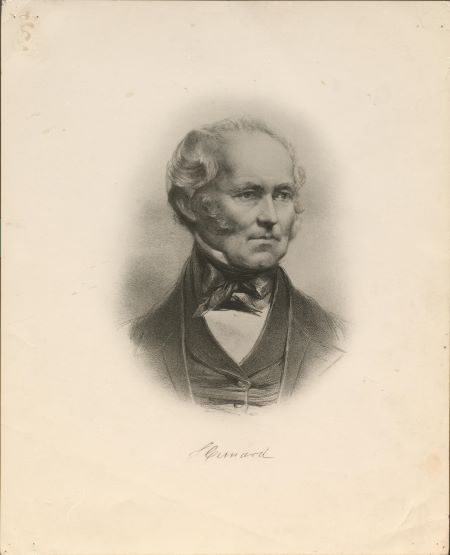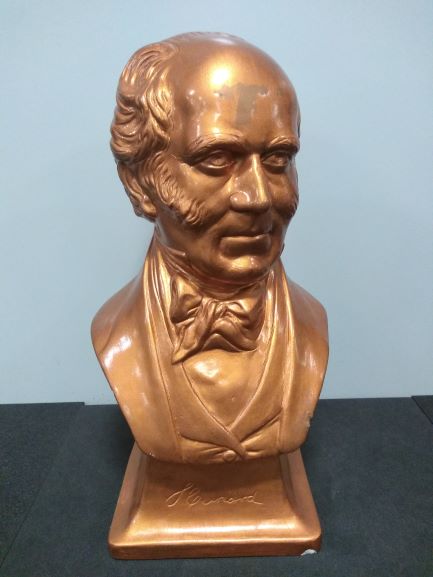This month marks 233 years since the birth of Sir Samuel Cunard, first baronet (1787-1865) – a shipowner from Halifax, Nova Scotia, who in partnership with George Burns, First Baronet (1795-1890) and David MacIver, a merchant from Liverpool, went on to found the British and North American Royal Mail Steam Packet Company (later becoming ‘Cunard’).

In May 1839 Samuel Cunard successfully secured a contract with the British Government – its purpose was to provide a scheduled transatlantic steamship service to carry mails across the Atlantic, the first of its kind. On 4th July 1840 Cunard’s ship, the 1,156-ton Britannia, left Liverpool and arrived on schedule in Halifax, Nova Scotia just ten days later, marking the company’s beginnings in transatlantic travel. Within a year Britannia and her three sister ships were providing the first timetabled weekly steamship service across the Atlantic.
Samuel Cunard made safety a priority and took a measured and steady approach when it came to the introduction of new technology. This conservative stance enabled his company to survive fierce competition from rival shipping companies.
Due to the historical significance of Samuel Cunard on the history of transatlantic shipping and the formation of the Cunard Company, SC&A often receives enquiries from researchers who are looking to source contemporary records from within the Cunard archive. It is perhaps surprising that very few records have survived from this period, and in particular those specifically relating to Samuel Cunard. We take a look at some of the records to be found within the Cunard archive that researchers may find of interest.
Agreement of Co-Partnership
One of the oldest records in the Cunard archive is an Agreement of Co-partnership signed by Samuel Cunard (1787-1865) and partners in May 1840. Some of the original partners included George Burns, First Baronet (1795-1890) and David MacIver, a merchant from Liverpool. Until 1934 this contract and a number of other documents, had been kept by the Glasgow firm that had prepared them for the founders of the Cunard Company. Until their chance rediscovery in an old deed box, details of Cunard’s early years and the formation of the shipping company had been vague. This was in part due to there being very few other surviving records.

MacIver Papers
Within the MacIver Papers (ref: D138/4) are a series of letters sent to Charles MacIver from Samuel Cunard in London and Glasgow (1 May 1847-22 Nov 1859). Handwritten and signed by Samuel Cunard, these letters provide a glimpse into the business activities of the company during this time and a rare opportunity to read the personal opinions of Samuel Cunard.

Secondary Sources and Recent Donations
Outside of contemporary records are notes and articles that the Cunard Company have pieced together about the family history of Samuel Cunard (ref: D42/PR3/1). Complimenting these are books on the history of the Cunard Company that often introduce readers to the life of Samuel Cunard, including his connection with Boston. Particular examples include the History of the Cunard Steamship Company (1886) SPEC 2015.b.003
Perhaps the most famous book written about Samuel Cunard is that of Steam Lion: A Biography of Samuel Cunard by John Langley who donated his collection of Cunard ephemera to the Cunard archive last summer. We are currently in the process of cataloguing this material and recently came across photographs showing the rededication ceremony of the statue of Sir Samuel Cunard in Halifax.


Further visual records of Samuel Cunard are limited to those images from the Public Relations Department, which include Charles Hopkinson making final amendments to Samuel Cunard’s portrait bust. It was therefore incredibly exciting to have been contacted by David Powers, a former employee of Cunard who wished to donate his large collection of material to the University to compliment the Cunard archive. Within this collection was a copy of the Samuel Cunard bust that had been displayed in Cunard’s New York office. We are pleased to share the news of this donation and will provide further updates once the material has been catalogued.
We hope these records and new donations provide inspiration to learn more about the individuals who went on to form the Cunard Company, one of the longest-serving names in shipping history.